The Eight Elements Practice: Absorbing and Harmonising Natural Energies
At this stage in the Course, we have explored multiple techniques for working with internal Qi, including generating, refining, and circulating energy within the body. We have also begun integrating external Qi absorption, learning how to draw in the energy of nature, such as from trees, bodies of water, the sun, and the moon. Now, we take this one step further by working with the eight fundamental energies of the universe, as represented by the Eight Trigrams (Pa Kua, 八卦).
The Eight Trigrams are an extension of the Five Phases (Wu Xing) and provide a more directional and functional understanding of how Qi moves in the cosmos, the natural world, and within us. They represent eight primary energetic forces that influence all life, each embodying a unique aspect of Qi movement.
The Five Phases — Wood, Fire, Earth, Metal, and Water — represent core energetic processes that shape both the natural world and the human body. Unlike the Western concept of “elements,” or the five-element systems in Yogic and Hermetic traditions, the Five Phases do not represent static substances but rather dynamic patterns of transformation and interaction. They illustrate the continuous flow of Qi, governing everything from the cycles of nature to the energetic functions of our internal organs.
However, while the Five Phases describe cycles of energy movement, the Pa Kua system expresses how these energies manifest in specific forms in nature. They represent the natural forces that shape the visible and invisible aspects of existence, forming a deep energetic blueprint for personal cultivation and cosmic alignment.
Each trigram corresponds to a natural element, an energetic quality, and a unique function in the body and environment.
The Eight Trigrams were first discovered and conceptualised by the legendary Taoist sage Fu Xi (伏羲), who is said to have lived over 5,000 years ago in ancient China. Fu Xi is credited with observing the natural world, the cycles of change, and the energetic patterns underlying all life.
According to legend, Fu Xi received divine inspiration upon witnessing mysterious patterns on the back of a tortoise’s shell as it emerged from the Yellow River. These markings revealed a cosmic code — a system of broken and unbroken lines that reflected the fundamental forces of existence. He organised these markings into the Eight Trigrams, each representing a different aspect of nature, movement of Qi, and energetic archetype.
Later, the great sage King Wen of Zhou (周文王, c. 1152–1056 BCE) refined Fu Xi’s system, arranging the trigrams into their modern order and developing the Sixty-Four Hexagrams (I Ching, 易经), which expanded the trigrams into a more complex system of divination, cosmology, and personal cultivation.
Each trigram (卦, Gua) is composed of three lines stacked vertically. These lines represent the fundamental dual forces of the universe: Yin and Yang.
- A solid line (—) represents Yang, the active, expansive, and creative force.
- A broken line (– –) represents Yin, the receptive, contracting, and nourishing force.
The Eight Trigrams emerge from the binary interactions of Yin and Yang through three levels of energy:
- Lower Line (Innermost Nature) – Represents the foundation or root energy.
- Middle Line (Transformation Process) – Represents how energy shifts and interacts.
- Upper Line (Manifestation in the Outer World) – Represents the expression or final outcome.
These three levels reflect the Taoist view of reality:
- Earth (Di, 地) – The lower line symbolises physical/material energy.
- Human (Ren, 人) – The middle line symbolises transformation and human experience.
- Heaven (Tian, 天) – The upper line symbolises divine/spiritual energy.
Through different arrangements of Yin and Yang over three lines, we get the Eight Trigrams, each of which is associated with a specific natural element, direction, season, organ system, and energetic quality.
The trigrams are as follows:
1. Heaven

Heaven’s tri-gram is composed of all solid yang lines; therefore it is strong and undivided. Heaven represents the celestial forces from which everything else dirives. It is the creative source, perfection, strength, vitality, originality, and power. All things are properly ordered: sun shines, rain falls, and people prosper. The organ associated is the brain, with the energetic qualities of leadership and creative force.
2. Earth
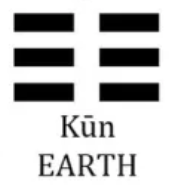
Earth’s tri-gram is three broken yin lines because the earth is open and receptive to rain, sun, and other natural forces. It is the complement to heaven. Earth represents the femininity of Mother Earth, the receptive yielding principle, and therefore is most yin.The organ associated is the stomach, with the energetic qualities of nurturing, receptivity and grounding.
3. Thunder

Thunder’s tri-gram is composed of two broken lines above a solid line; Therefore thunder hits solidly yet rises to disperse. Thunder represents dynamic movement, activity, vitality, development, and growth.The associated organ is the liver, with the energetic qualities of activation, power, movement and stimulation.
4. Water
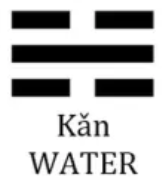
Water’s tri-gram is composed of broken yin lines on top and bottom with a solid line in the centre. Water may seem clear and uniform yet it does have a solid mass in the centre. For example, a wave will crash when the top surface water moves at a faster rate than the solid centre mass.The associated organ is the kidneys, with the energetic qualities of fluidity, intuition, adaptability and mystery.
5. Mountain
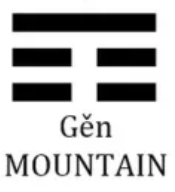
Mountain’s tri-gram is composed of a solid line above and two broken lines below. Below the solid top is space, indicating a cave inside the mountain. This huge immovable mountain represents meditation, movement halted, and resting of body, mind and spirit. The organ associated is the spleen, with the energetic qualities of stability, stillness and contemplation.
6. Wind

Wind’s tri-gram is composed of two solid lines above a broken line. The two solid lines in heaven and the middle kingdom show the gentle strength of wind over the broken lines of the earth below.The organ associated is the gall bladder, with the energetic qualities of penetration, flexibility and wisdom.
7. Fire
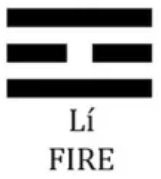
Fire’s tri-gram is composed of a solid yang line on top and bottom with a broken yin line in the middle. Like a flame, fire appears to take form yet its core is empty. The organ associated is the heart, with the energetic qualities of illumination, brightness, understanding and passion.
8. Lake
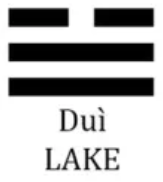
Lake’s tri-gram is composed of a broken yin line above two solid lines. A lake is open and receptive on the surface yet contains mass below. (Unlike water which is open on the bottom to create running water.) The organ associated is the lungs with the energetic qualities of enjoyment, enthusiasm, openness and communication.
Fu Hsi paired the eight trigrams according to their opposites. Heaven is paired with earth, fire with water, mountain with lake, and wind with thunder. Fu Hsi observed that how these pairs act upon each other. He arranged the trigrams (in what is now known as the ‘early heavenly sequence’) with the opposites across from each other. Moving clockwise from the top, heaven opposes earth, wind opposes thunder, water opposes fire, and mountain opposes lake. The result is the following diagram, which is simply called “the Pa kua“.
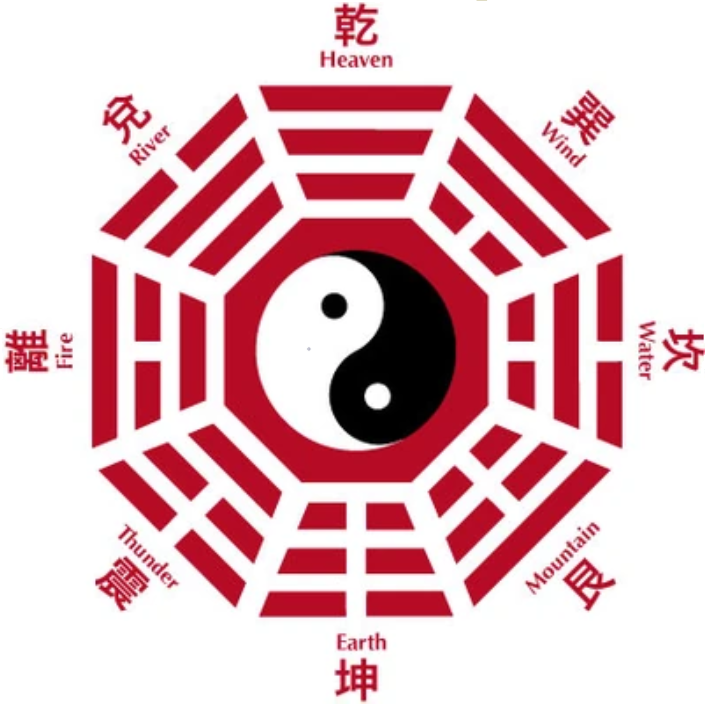
Together, the Eight Trigrams provide a comprehensive map of Qi movement and how it interacts with human consciousness, physical health, and cosmic forces. In the centre of the circle is the interpay of yin and yang, from which these aspects of nature emerge.
The Practice
The Eight Elements Practice is a Pa Kua-based Qigong technique that attunes practitioners to these fundamental forces of nature. Each trigram represents an element and energetic function that can be actively cultivated through breathwork, visualisation, and intentional Qi absorption. This practice allows one to absorb, balance, and refine Qi from each trigram’s corresponding energy. Through the practice we can draw in these energies, integrate them into the body, and use them for healing, transformation, and spiritual growth.
This practice allows us to:
- Align with natural forces and deepen our connection to the greater Qi field.
- Balance internal energy by drawing upon the qualities of each trigram.
- Strengthen physical and emotional health through interaction with elemental Qi.
- Enhance spiritual awareness by harmonising with the cosmic flow of Qi.
Practice Guide – Basic Practice
This practice allows us to draw in, harmonise, and embody the eight primary energies of nature.
Optimally, it should be done in an open outdoor setting, preferably near a place where you can observe natural features that correspond to the different elements (e.g., mountains, bodies of water, open sky, etc.). However, it is also possible to do the exercise with just imagining those natural features.
Please watch the video below for the basic version of this practice.
[INSERT VIDEO]
A written description of the practice is provided at the Exercise Files tab.
After you have completed the exercise, please note your experience in your Course Journal.
Advanced Variations
Advanced Variation #1: Cycling the Eight Elements in the Microcosmic Orbit
Once you have familiarised yourself with the individual energies, you can take the practice further by cycling each element through the Microcosmic Orbit.
- Inhale an element’s Qi into the lower tan tien.
- Exhale and guide that Qi from the tan tien, down into the perineum, then up the spine, over the head, and down the front of the body. Complete 3, 6, or 9 cycles and then reverse the direction for the same number of cycles.
- Complete by drawing the energy into the tan tien and spinning it in there.
- Do this for each of the eight energies, then seal and store as in the basic practice.
Advanced Variation #2: Utilising the Trigram Drawings
In this advanced variation of the Eight Elements Practice, we deepen our connection to the Pa Kua system by actively inscribing the trigrams into our energy field. By using the index finger to trace the trigrams over the lower tan tien, we reinforce the energetic imprint of each trigram and enhance the absorption of its associated Qi. This practice serves as both a meditative and energetic tool, strengthening our internal alignment with the natural forces represented by the Pa Kua.
In this practice, we create the Pa kua octagon over the entire sphere of the tan tien, with the yin-yang symbol located right at the centre of the tan tien. The yin-yang symbol is always spinning, drawing the energies of each element into the centre of the tan tien.
Practice Guide
(i) Assume the Correct Posture
- Sit comfortably with your spine upright, or stand in a relaxed yet stable position (such as the Simple Stance).
- Relax your body and focus on your breath for a few minutes, breathing in and out of the nose.
(ii) Activate the Index Finger
- Extend your index finger, lightly rubbing the fingertips together to activate sensation.
- Feel the subtle energy extending from your fingertip, visualising a fine stream of light or energy projecting outward.
(iii) Draw the Trigrams
- Using your index finger, begin tracing the three solid lines of the Heaven trigram (in the place where the Heaven Trigram is usually located, at the top of the Pa Kua, as in the image above)
- Visualise the energy of that element flowing from the universe into the trigram, and then spinning into the yin yang symbol at the centre of the tan tien.
- Spend 3-5 minutes absorbing the energy of that element, ensuring to note the quality of its energy within you before you move on.
- Follow the traditional arrangement of the Pa Kua, with the next trigram being Wind, drawing each trigram with awareness of its associated energy and meaning.
- As you complete each trigram, pause briefly to feel the energetic resonance before moving on to the next.
(iii) Seal the Energy
- Once all eight trigrams have been drawn, feel the entire octagonal energy structure over your tan tien.
- Hold your hands over the tan tien, allowing the energetic imprint to settle and integrate into your system.
- Take a few deep breaths, focusing on the sensation of stability and energetic alignment.
(iv) Conclude the Practice
- Bring your hands to your navel, gently massaging the area in the collection process described earlier in the Course (Section 8, Lesson 2) to seal the energy.
- Express gratitude for the practice and the energetic forces you have engaged with.
- Slowly return to a state of normal awareness, allowing the effects of the practice to integrate naturally.
